Tuesday, December 05, 2006
Returning to the world of anime otaku
Two months have gone by since I posted here last. It's not that I don't have stuff I want to write about. It's mostly that I have been so absorbed in my new job at Opera. I haven't had time to pursue some of my old interests. That's set to change, however, at least briefly. There are a couple of otaku-related events coming up that I'll be attending.
Japanamerica launch party
First of all, my friend Roland Kelts just released a book called Japanamerica: How Japanese Pop Culture Has Invaded the U.S.. I met Roland after a seminar I gave last summer on otaku culture in Japan and the US. In the months that followed, he interviewed me for his book. I haven't read it yet, but supposedly, I have some quotes in it. I'll review it as soon as I get a copy.
Anyhow, Roland invited me to the book's launch party tomorrow in Manhattan (at The Cutting Room). I'm really looking forward to it (believe it or not, I kind of miss the east coast's cold weather).
More information on the book can be found here: Japanamerica by Roland Kelts.
Anime Punch! 2007
Last year, I was invited to be a guest at Anime Punch!, an up-and-coming anime convention in Columbus, Ohio. I had a great time, and I'm happy to announce that they've graciously invited me back for the 2007 event in late March. If you can attend, please stop by one of my panels. I'll most definitely talk about otaku culture again, but I'll try to come up with some new panels as well. Suggestions are always welcome, and I'll try to be more active this year on the con's official forums. When the con date gets closer, I'll post more details.
Wednesday, October 04, 2006
Attn: Friends of Robert Anton Wilson
Yesterday, I came across the sobering news that Robert Anton Wilson (RAW for short) is in poor physical condition and desperately needs financial assistance. Some may know him as the co-author of the cult classic Illuminatus Trilogy, and others have enjoyed his mind-bendingly profound and funny works of non-fiction. Traces of his work can be found all over pop culture for those who know where to look.
Anyhow, RAW's plight was blogged about on Monday and his friends have put out a general call for donations to make his final days just a little more pleasant. I know firsthand how bad healthcare costs can be in the US, and RAW's works have affected me more than a little, so I've already sent in my $50, and I'm certainly not the only one who felt the need to do so. The outpouring of goodwill from RAW's fans has been an amazing thing to witness.
If you don't know RAW's works firsthand, perhaps you know lainspotting because of my anime site, thought experiments lain. There are probably a lot of things in my life that would be very different if I hadn't read the collected works of Robert Anton Wilson, but I know for sure that TEL would not have happened without him. Much of my analysis of serial experiments lain is based on principles and ideas I was exposed to through RAW. I mention him on the website more than once, and I feel good knowing that maybe a few anime fans learned about him through my work.
I had the pleasure of hearing RAW speak in person in 1999, less than a month after his wife of over 40 years passed away. He looked very tired, but he still showed up for the speaking engagement in a small bookstore in Riverside, California. He was everything I expected and more, and I only wish I had taken the opportunity to speak to him. Today, I consider it an honor to help out a man who has helped so many others through his writing, and who has always presented himself humbly despite his unique and great gifts.
Sunday, August 27, 2006
Big Changes
After a several month break from posting, I'm finally back! In case you don't know where I've been, I was writing my doctoral dissertation (on otaku culture in America, especially anime and manga fandom). As of 3 weeks ago, I completed all the requirements for my PhD. Some 25 years of schooling (kindergarten through grad school) are behind me at last.
I just wanted to take this opportunity to thank all of the interviewees and those of you I hung out with during the course of my research. If you volunteered to be interviewed and I didn't get around to you, I'm sorry we weren't able to sit down and chat some more, but thank you nonetheless for your enthusiasm and willingness to help. Our interactions, though brief, were still important to me.
Getting my PhD feels great, but I'm excited about things coming up, as well. Many graduating PhDs scour the job market for academic jobs, and I did that a little bit, but I ultimately decided to do something a little different. Readers of lainspotting and especially Opera Otaku know that I'm a big fan of the Opera browser and the company that makes it. Starting in September, I will be working for Opera Software full time at their San Diego branch office. (Because of my very recent move from New York to California, I haven't had time to write until now.) Long time readers will remember that I wrote an article about branding and Opera back in early 2005, and I visited Opera's main headquarters in Oslo, Norway last summer. As such, I've had an informal relationship with the company for quite awhile now. With the completion of my degree, I'm happy to become a full-fledged member of the Opera team.
Utilizing my research background, a major part of my work will involve really getting to know American users of Opera: die-hard fans and casual users alike. Furthermore, I'll be talking with people who don't use the browser to determine how Opera might better serve their needs as well. Once I start my new job, I'm sure I'll be writing more (either here or elsewhere) about my experience of working at Opera, so stay tuned!
Monday, May 29, 2006
My Otaku Room
For the Weekly Anime Review episode featuring an interview with yours truly, Aaron used an image of an otaku's room. Someone asked me if the picture was of my room. It isn't. While I like figures, I don't collect a whole lot of them. I mostly collect posters, artbooks, and other rare stuff I can get ahold of related to my favorite anime.
I've posted photos of my home office / anime-haven before, but it's been awhile. The following photos are the most recent, taken about a year ago (before Rowan was born). Since then, in order to put in Rowan's crib and changing table, I have moved some things around and removed the guest bed. (Rowan still gets to enjoy the posters, though.) Except for select titles that I like to have close by, I keep my modest anime and manga collection in other rooms (such as the living room where my TV and PS2 reside). Naturally, since these photos are over a year old and I don't typically throw things away, I have more stuff now.


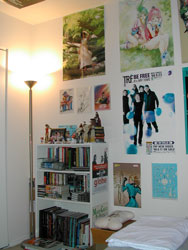
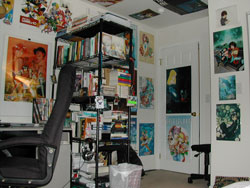
Update 07/10/09: I recently started a group on Flickr to highlight people's Otaku Rooms. I hope you'll check it out and share your photos!
I've posted photos of my home office / anime-haven before, but it's been awhile. The following photos are the most recent, taken about a year ago (before Rowan was born). Since then, in order to put in Rowan's crib and changing table, I have moved some things around and removed the guest bed. (Rowan still gets to enjoy the posters, though.) Except for select titles that I like to have close by, I keep my modest anime and manga collection in other rooms (such as the living room where my TV and PS2 reside). Naturally, since these photos are over a year old and I don't typically throw things away, I have more stuff now.




Update 07/10/09: I recently started a group on Flickr to highlight people's Otaku Rooms. I hope you'll check it out and share your photos!
Saturday, May 27, 2006
Talking About Otaku with Weekly Anime Review
I'm too busy these days to write much here, and I expect it will be like that for the next two months, but if you'd like to literally hear me talk about otaku, I was recently interviewed by Aaron of Weekly Anime Review, an excellent podcast that I mentioned previously on lainspotting. The interview is the main feature of the latest episode, found here: Episode 33 - Otaku Studies With Lawrence Eng
I was on a cell phone, so my voice is definitely muffled, but if you turn up the volume, you should be able to hear what I'm saying. I'm much more comfortable writing out my thoughts than articulating them verbally, especially in an unscripted interview (as opposed to a formal presentation), but it was a nice change of pace (since I'm the one who usually does the interviewing) and I think it turned out pretty well. If you're visiting this site for the first time because you heard the interview, welcome! (There's a lot of material spread out all over the place, so feel free to explore.)
In case people were wondering, my conversation with Aaron was actually longer than what's presented, but he edited some stuff out to keep things on topic. For example, we spent some time talking about my lain website and how it came about. In general, Aaron did a great job of editing. The only weird bit I noticed was when I was talking about Kino's Journey, and then it abruptly jumped to me talking about otaku again, but other than that, the editing was smooth.
Wednesday, May 17, 2006
Earliest mentions of "otaku" in anime or manga?
The last couple of posts have been very text-intensive, so here's a quick question and a chance for me to post a nice image.
Does anyone reading this know the earliest usage of the term "otaku" (in the uber-fan sense) in an anime or manga? All you masters of old school anime, here's your chance to show your stuff.
The earliest usage I know of is in Volume 2 of Gainax's Aim for the Top! Gunbuster (one of my all time favorites), released on January 1st, 1989 (on VHS). Noriko is called an otaku by Kazumi in the science lessons following episode 4. You can look at the translated script here: "Top wo Nerae -- GunBuster -- Vol. 2"
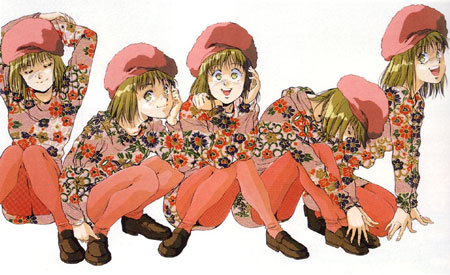
Takaya Noriko from Gunbuster
If you know any earlier anime or manga mentions of "otaku" (as fans), feel free to leave a comment or send me an email. Thanks!
Does anyone reading this know the earliest usage of the term "otaku" (in the uber-fan sense) in an anime or manga? All you masters of old school anime, here's your chance to show your stuff.
The earliest usage I know of is in Volume 2 of Gainax's Aim for the Top! Gunbuster (one of my all time favorites), released on January 1st, 1989 (on VHS). Noriko is called an otaku by Kazumi in the science lessons following episode 4. You can look at the translated script here: "Top wo Nerae -- GunBuster -- Vol. 2"

Takaya Noriko from Gunbuster
If you know any earlier anime or manga mentions of "otaku" (as fans), feel free to leave a comment or send me an email. Thanks!
Sunday, May 14, 2006
A different perspective on Japan's "Otaku Boom"
On Friday, I came across the following article on the Mainichi Daily News site, in the WaiWai section (which generally features tabloid journalism): Self-professed 'real otaku' rips into 'moe' fetish fakers.
While the article, featuring harsh commentary by manga artist Mimei Sakamoto, is clearly meant to ruffle feathers and create a stir, it provides an interesting perspective on otaku identity politics in Japan. The article brings up some points that I'd like to discuss.
Non-otaku in the mainstream Japan criticizing otaku culture is nothing new. Less common are those people who are deep into otaku culture who have a problem with either a) certain subfactions of otaku, and/or b) mainstream perceptions of otaku. Previously, when otaku were still heavily discriminated against (in the years following the Miyazaki incident), we had well-known figures such as Toshio Okada and Takashi Murakami speaking up in defense of otaku culture. Now, however, as otaku have become more mainstream and accepted in Japanese society, we have otaku such as Toru Honda and Mimei Sakamoto speaking out against the current "otaku boom", but each with a very different message.
As I wrote about in an earlier blog post, Toru Honda is a hardcore otaku who speaks in favor of otaku culture, but is not pleased with the sterile and cutesy image of otaku that now dominates Japanese media. Instead, Honda prefers to emphasize the darker and more dangerous side of otaku (i.e. the extreme otaku who prefer stylized 2D female characters over real life women). Mimei Sakamoto, who also considers herself an otaku, is likewise displeased with the new glamorization of otaku culture. In direct contrast to Honda, however, Sakamoto's main criticism is that celebrating otaku who are unstylish and interested in moe has the unfortunate side effect of justifying the darker side of otaku obsessiveness (a side she definitely disapproves of).
In particular, Sakamoto rails against moe as being "pedophiliac fetish" and "nothing more than perversion", and also criticizes otaku for being "incapable of recognizing reality" and being "incapable of being in a normal loving relationship". In response to this, I feel compelled to defend moe in principle because I don't think there is anything wrong with or perverse about enjoying well-drawn characters and finding them attractive, any more than it's wrong to feel attracted to an interesting character in a novel or television show.
It is true that some anime and game characters designed to be attractive to otaku are very young looking (clearly drawn to look like minors, in other words), a fact that has certain moral implications to be worked out by the individual who chooses whether or not to like them. So far, in the United States, even when such drawings are explicitly pornographic (and most of them are not), they have been deemed legal and protected speech, in that they do not directly harm real life children (unlike actual child pornography which is widely agreed to be a form of child exploitation and abuse).
Sakamoto's argument against moe on the basis that it is "pedophiliac" suffers when one considers that a) not all moe characters look like children, b) moe characters are not always portrayed in a sexualized manner, and c) those who appreciate young characters do not necessarily view them in a sexual way (in fact, some people define moe as having nothing to do with sexual feelings).
That said, I do understand somewhat where Sakamoto is coming from. While there is plenty of innocuous moe stuff out there (a lot of it is just really cute), one cannot deny the existence of some moe that portrays young characters in less than innocent ways, and whatever you think about such images, it's not surprising that Sakamoto is upset by them. The bigger issue is whether or not such images should be banned completely. According to an Anime News Network poll conducted last year, about 39% of American anime fans do not think they should banned, 20% think they should be banned in certain situations, but not others, while only 29% think they should be banned completely (the remaining 12% were undecided). When debating the issue, many fans defend such images on the basis of free speech (and a perspective that denies the existence of thought crimes), though they also respect that not everyone has to personally like or approve of such images, and certainly noone should be forced to look at them.
Sakamoto brings up a related issue that is even more controversial--the "idolizing" of young girls in Japan (which is more than just an otaku thing). U-15 (under 15) idol stars appear to be gaining in popularity in Japan, but not without some serious concern and criticism. Like Sakamoto, I see this (the popularity of sexualized young idols) as a disturbing trend; it seems very close to being (or maybe just is) a form of child exploitation. Young models exist in the US as well, but they aren't as mainstream here, and they too are surrounded by a fair bit of controversy.
In contrast, Sakamoto's complaint about otaku liking "women wearing spectacles" seems unimportant, akin to complaining about men liking women who wear swimsuits at the beach. Being angry at those who fetishize glasses-wearing seems unnecessary at best, intolerant at worst, similar to her displeasure regarding those "guys walking around in thick glasses and checkered shirts". (I've never been a master of fashion, but my wife likes me just fine, thank you very much.)
Sakamoto is not necessarily wrong to question otaku who are "incapable of recognizing reality" and "incapable of being in a normal loving relationship", assuming that most of us agree that reality and healthy relationships are important. There are some otaku who really are like that, and maybe they could use some help. It's important to note, however, that not all (or even most) otaku are thus afflicted; hopefully, Sakamoto realizes that.
While I think Sakamoto is overly harsh and often overgeneralizes, I do appreciate the fact that she is willing to speak out against specific things she does not like about otaku culture, and the specific way it is being popularized in Japan.
To me, not all moe is as bad as she makes it out to be. Likewise, not all otaku are incapable of healthy social relations. On the other hand, I do think it's somewhat of a shame that when talking about otaku, the Japanese media focuses so heavily on moe and otaku who have trouble socializing with non-otaku. Light-hearted news segments about 'weird otaku' and business reports regarding the massive amounts of money moe generates for the Japanese economy have overshadowed any serious discussion of the deeper sociological (and moral) issues surrounding otaku culture.
From my perspective, there are so many interesting things about otaku that are almost never talked about. Sakamoto touches on one of those things in her complaint that "otaku are caught up in this money making cycle and all they're doing is spending their hard-earned yen". The way that otaku choose to consume and engage with media and other technology is a topic close to my heart. Maybe the situation is different for otaku in Japan (since Japanese otaku are the direct target audience for many anime), but I feel that otaku in America have a long history of having a certain amount of control over their media consumption, that they are able to consume on their own terms, whether by maintaining vast fansub networks that exist outside of mainstream distribution channels, or by maintaining close relations and open dialogue with American anime publishers. (My forthcoming PhD dissertation will discuss this further)
Finally, I can't quite make sense of the final paragraph about "real otaku" shutting themselves away from the world. Perhaps the translation was poor. Reading that paragraph, I wonder if Sakamoto has some significant self-esteem issues, if she feels conflicted about her otaku identity. While the mainstreaming of all things labeled "otaku" is not necessarily good for society, her solution of locking oneself up seems even more destructive (and reminiscent of Japan's hikikomori problem).
Thursday, May 11, 2006
Apple TV commercial disses geeks?
Well, not precisely, but close enough. I consider myself an Apple fan, but I'm not a huge fan of the commercial ("Network") in question.
If you haven't seen it yet, here it is.
The important part to note is the Japanese dialogue spoken by the digital camera woman. After some basic pleasantries, her last line can be translated to "he looks kinda otaku-ish".
Now, regular readers of this blog or people familar with my writings and research in general have heard me talk about otaku over and over. For those of you unfamiliar with the term, I'll point you to my most commonly-cited otaku essay: "The Politics of Otaku" (which has links to more information). To make a long story short, it's not wholly inaccurate to translate 'otaku' as 'geek'. There are some important distinctions between 'otaku' and 'geek', but they are very closely related ('anorak' might be even better, but only British readers will get that).
So why am I bringing this up? I have to say that I was somewhat surprised to see 'otaku' used in the Apple ad that way. Of course, most Americans watching the ad won't know what she said, and the main point of the ad is simply that the PC guy doesn't know how to communicate with the Japanese digital camera woman, leading to an awkward moment for him. It also appears that the Mac guy and the digital camera woman are sharing an inside joke, chuckling while the PC guy is forced to look on, feeling excluded.
Of course, with the internet, it's very easy for television viewers to find out what she said, and as it turns out, she was mentioning how the PC guy looked kind of like an otaku (or a geek, or nerd if you prefer), and then laughed about it with the Mac guy.
Why did they have her say that? Yes, it's true that otaku are not always looked upon very highly by certain segments of Japanese society, but did Apple really want the protagonist of their commercial to engage in or sympathize with outright mocking of otaku/geeks? It seems a little distasteful. After all, don't we affectionately consider Jobs and Wozniak to be geeks? Furthermore, in the last year, otaku have enjoyed a wave of positive media attention in Japan [see my article The Evolution of Otaku Concept for more discussion of that].
Another weird thing about the statement she made is that the PC guy doesn't look anything like an otaku. Now, I'm not a fan of physical stereotyping, and I know that otaku come in all shapes and sizes, and are not restricted to any particular "look", but given the PC guy's conservative and business formal attire, I can't figure out why she would say he looks like an otaku. She might be referring to his general build, haircut, and/or glasses, and if that's the case, it's even more shocking that Apple would have a commercial making fun of those things. Maybe the guy doesn't have the look and presence of an action movie star, but so what? What ever happened to the philosophy behind the Apple Switch ads featuring regular looking people as the stars?
Just like in the US, there are people in Japan (many of whom might be considered otaku) who are really into Apple Computer products. Why would the company risk alienating its otaku userbase in Japan, not to mention all the PC-using otaku? Apple is all about passionate, free-spirited, and iconoclastic users, so such an ad is an odd contradiction and possibly a foolish move.
There are the plenty of Americans (anime and manga fans, mostly) who call themselves 'otaku', as well. This ad doesn't speak very well to them, either.
To me, the most ironic thing is that this commercial might very well be the most widely broadcasted use of the word 'otaku' in American television history. Let's hope Apple (or whoever else) does it better next time.
[Thanks to Lillian for providing the translation]
Thursday, May 04, 2006
My 50 Favorite Movies
This list is mostly for my own benefit. I started it a few weeks ago, and have decided to put it online for easy access. When new movies make the list, I'll edit accordingly.
I did not include my favorite anime, documentaries, or TV shows. As you can see, my tastes are kind of geeky and/or sentimental. [More interesting than what's on the list, perhaps, is what I've left off.]
My top 50 movies are divided into three tiers. I had a top 10 (the first tier), a second tier of 10, and a third tier of 30. Within each tier, the movies are not ranked against each other (but are listed in alphabetical order, instead). The short comments are the same as my Netflix "Two Cents" reviews.
Tier 1 (10 movies):
The Adventures of Buckaroo Banzai Across the 8th Dimension
A quirky cult classic with colorful characters and a unique sense of style
Dune
Cult sci-fi. I grew up watching the extended version on TV
Faraway, So Close!
Poetic, beautiful, and moving. The source of "Raphaela"
Pollyanna
One of the most perfect movies ever made
Some Kind of Wonderful
The perfect 80's teen movie
The Good, the Bad, and the Ugly
Sergio Leone's direction plus Clint Eastwood's performance plus a great supporting cast = greatness
The Great Escape
Action adventure with memorable characters, brilliantly performed
The Right Stuff
An American classic
Tron
Extremely ambitious and visionary, with a great story to boot
WarGames
They don't make technothrillers like this anymore
Tier 2 (10 movies):
Battle Royale
A story of youth rebellion against a society that fears, torments, and uses them as an example
Enter the Dragon
The quintessential Bruce Lee movie, filmed at the height of his physical condition and ability
Harry Potter and the Sorceror's Stone
"It has all the magic and wonder of the original", because it is the original! (yes, I saw the movie first)
Mr. and Mrs. Smith
A surprisingly nuanced and funny romance, enhanced by excellent action sequences and gunplay
On the Edge
Primer
Taut, well-written sci-fi on a budget
Red Dawn
You don't have to be a right-winger to be moved by this beautiful vision of near-future dystopia made in the 80's
Star Trek II: The Wrath of Khan
My favorite Trek movie; the soundtrack by James Horner is magnificent
The Hunt for Red October
The first Jack Ryan movie is my favorite by far
Tomorrowland
What many critics miss about Tomorrowland: it's less about nostalgia for old visions of the future, and more about a revival of the spirit
Tier 3 (30 movies):
A Better Tomorrow II
A Knight's Tale
All the President's Men
Armageddon
Basquiat
Battlestar Galactica
Breaking Away
Cinema Paradiso
Conan the Barbarian
Contact
Drumline
Fast Times at Ridgemont High
Gabbar is Back
Ghostbusters
Great Balls of Fire
Love Actually
Margin Call
Music and Lyrics
Ocean's Twelve
Once Upon a Time in America
Once Upon a Time in China 3
Pi
Push
Searching for Bobby Fischer
Speed Racer
Spider-Man 2
Star Trek IV: The Voyage Home
The Andromeda Strain
The Rock
Until the End of the World
Honorable mentions (recently bumped out of the top 50):
Blade Runner
Cool Hand Luke
Crimson Tide
Hero
Kate & Leopold
Lara Croft: Tomb Raider
Papillon
Redbelt
Taxi Driver
The American President
The Longest Day
The Outlaw Josey Wales
The School of Rock
The Transformers: The Movie
Zoolander
I did not include my favorite anime, documentaries, or TV shows. As you can see, my tastes are kind of geeky and/or sentimental. [More interesting than what's on the list, perhaps, is what I've left off.]
My top 50 movies are divided into three tiers. I had a top 10 (the first tier), a second tier of 10, and a third tier of 30. Within each tier, the movies are not ranked against each other (but are listed in alphabetical order, instead). The short comments are the same as my Netflix "Two Cents" reviews.
Tier 1 (10 movies):
The Adventures of Buckaroo Banzai Across the 8th Dimension
A quirky cult classic with colorful characters and a unique sense of style
Dune
Cult sci-fi. I grew up watching the extended version on TV
Faraway, So Close!
Poetic, beautiful, and moving. The source of "Raphaela"
Pollyanna
One of the most perfect movies ever made
Some Kind of Wonderful
The perfect 80's teen movie
The Good, the Bad, and the Ugly
Sergio Leone's direction plus Clint Eastwood's performance plus a great supporting cast = greatness
The Great Escape
Action adventure with memorable characters, brilliantly performed
The Right Stuff
An American classic
Tron
Extremely ambitious and visionary, with a great story to boot
WarGames
They don't make technothrillers like this anymore
Tier 2 (10 movies):
Battle Royale
A story of youth rebellion against a society that fears, torments, and uses them as an example
Enter the Dragon
The quintessential Bruce Lee movie, filmed at the height of his physical condition and ability
Harry Potter and the Sorceror's Stone
"It has all the magic and wonder of the original", because it is the original! (yes, I saw the movie first)
Mr. and Mrs. Smith
A surprisingly nuanced and funny romance, enhanced by excellent action sequences and gunplay
On the Edge
Primer
Taut, well-written sci-fi on a budget
Red Dawn
You don't have to be a right-winger to be moved by this beautiful vision of near-future dystopia made in the 80's
Star Trek II: The Wrath of Khan
My favorite Trek movie; the soundtrack by James Horner is magnificent
The Hunt for Red October
The first Jack Ryan movie is my favorite by far
Tomorrowland
What many critics miss about Tomorrowland: it's less about nostalgia for old visions of the future, and more about a revival of the spirit
Tier 3 (30 movies):
A Better Tomorrow II
A Knight's Tale
All the President's Men
Armageddon
Basquiat
Battlestar Galactica
Breaking Away
Cinema Paradiso
Conan the Barbarian
Contact
Drumline
Fast Times at Ridgemont High
Gabbar is Back
Ghostbusters
Great Balls of Fire
Love Actually
Margin Call
Music and Lyrics
Ocean's Twelve
Once Upon a Time in America
Once Upon a Time in China 3
Pi
Push
Searching for Bobby Fischer
Speed Racer
Spider-Man 2
Star Trek IV: The Voyage Home
The Andromeda Strain
The Rock
Until the End of the World
Honorable mentions (recently bumped out of the top 50):
Blade Runner
Cool Hand Luke
Crimson Tide
Hero
Kate & Leopold
Lara Croft: Tomb Raider
Papillon
Redbelt
Taxi Driver
The American President
The Longest Day
The Outlaw Josey Wales
The School of Rock
The Transformers: The Movie
Zoolander
More otaku video clips, and some thoughts on Kevin Underwood
Video clips
In late January, I posted links to two clips by "Yamato Damacy" that featured otaku and Akihabara. In the meantime, they've posted two more videos that feature otaku culture. I enjoyed them, though the otaku interviewed at the end of Episode #18 was probably being too down on himself. Follow the links below:
Episode #18, Otaku
I also came across a video segment called "Otaku from USA", posted in the following blog: TV in Japan: Otaku from USA.
It's a clip from a Japanese TV show that followed around and interviewed the members of a Pop Japan Travel tour. I went on one of those as well, but we didn't get the same amount of Japanese media coverage (just a newspaper article with a photo, and a little video footage during the Sapporo Snow Festival). For a full length documentary featuring a Pop Japan Travel tour, check out Seven Days in Japan by Joe Doughrity.
Kevin Underwood: An American otaku-murderer?
26-year-old Kevin Underwood was recently arrested for the murder of a little girl, whose body was found in his apartment. It has been a high profile incident, not just because of the crime's brutality, but because of Underwood's significant internet presence (he maintained various blogs, for example), allowing crime analysts (professional and amateur alike) to peer into his clearly troubled psyche. He was into a lot of things: sci-fi, movies, music...typical stuff, really, for someone his age who spends a lot of time on the internet. More telling was his apparent interest in serial killers and cannibalism. I mention him here because he was also into anime. The nature of his crime and his interest in anime have caused some on the internet to draw parallels between him and Tsutomu Miyazaki.
Miyazaki, of course, was the infamous child-murderer who, due to his vast collection of videos (anime, horror movies, and child porn, according to most reports), was publically called an otaku by the Japanese media, sparking a moral panic against otaku in general in the late 80's and early 90's. I do agree that there are interesting parallels between Miyazaki and Underwood, but I find it ironic when people label Underwood as an otaku. Miyazaki being called an otaku resulted in an unfortunate backlash against anime fans in Japan. While Underwood's crime is similar to what Miyazaki did, are we to repeat what the Japanese media did over a decade-and-a-half ago, creating a backlash against anime fans in America by focusing on Underwood's anime habit? [Anime was apparently only one facet of his wide-ranging interests; he does not appear to have blogged about anime-related subjects very much since 2004]
Luckily, linking Underwood to anime hasn't really happened yet on any large scale, and the network news coverage of the incident hasn't really touched on anime at all. Hopefully, they will focus less on the media he was into and try to understand the deeper causes of his crime. Unfortunately, we may never know the real answer. Even in the case of Tsutomu Miyazaki, after all these years, there is still debate about his motivations and what really happened. (The following article has an excellent discussion of that: Sifting through the geeks - that's all of us - to identify the perverts)
I find myself a bit puzzled as to why more people have not made a connection between Underwood's self-professed social anxiety and Japan's hikikomori problem, since the hikikomori phenomenon is often associated with social anxiety disorder. When reading some of Kevin Underwood's blog posts, I was more reminded of the disturbed hikikomori protagonist of Welcome to the N.H.K. than the easy-going otaku portrayed in Genshiken (which is not to say that I think being hikikomori or having social anxiety disorder necessarily leads to violent behavior).
Tuesday, April 18, 2006
New Lain PVC Figure Announced
For those of you who have been reading lainspotting since the early days, here's some actual lain news for a change.
A new 6 inch PVC Lain figure by Vice has been announced, scheduled to be released in late May. It is already available for pre-order at various online retailers.
Check out the official website for the figure. On that site, the figure is listed as costing 6510 Yen.
Here is an image of the figure (taken from the official site) followed by the original source image (from an omnipresence in wired, image courtesy of Per Hedbor's Serial Experiments Lain: Root)


I'll post better pictures of the figure in May.
Monday, April 17, 2006
A Pair of Otaku-related Podcasts
I'm not a regular listener/watcher of podcasts, but here are two that recently caught my attention.
Anime for the Lazyman
Actually, I first heard about "Anime for the Lazyman" on G-pen.com several months ago when I was asked whether or not they could link to some of my otaku-related essays in the notes for Episode 4. I gladly gave permission, but due to laziness on my own part combined with a lot of other stuff to do, I put off watching the episodes for quite awhile. I finally did watch them, however, and was really entertained in the process.
The video podcast is hosted by Chi, a graduate of USC's film school and currently a graduate student at the Tokyo University of Technology. He is also currently working at an anime company in Japan. Most episodes of "Anime for the Lazyman" so far have featured three people--Chi, a company employee, and "The Boss"--sitting in front of the camera talking about anime, the anime industry in Japan, and otaku culture. Chi considers himself a mid-level otaku, pretty knowledgeable about the most popular anime titles, but not the type of fan who watches everything and anything just because it's anime. The company employee is usually a woman who offers her perspective as someone who knows a little bit about anime but isn't really a fan, and certainly would not consider herself an otaku. "The Boss", even though he doesn't necessarily identify with the current generation of Japanese otaku, is the most otaku of the bunch in the sense that he knows the most about anime and strongly believes that it is important to learn more and to spread awareness of anime around the world in order to encourage a free flow of ideas that will result in more creative anime productions in the long run.
Chi and the company employee (different episodes feature different employees) have interesting thoughts, but it's "The Boss" who really steals the show with his humor and manic energy. You don't ever get to see his face, but you can tell he feels strongly about anime and improving the state of the industry. If we are to call him an otaku, it's because he's creative, passionate, and critical like the protagonists of Otaku no Video as opposed to the laid back and middle-of-the-road protagonists of Genshiken. Maybe he's not always right about everything, but he puts forth his opinions in such a straightforward, convincing, and humorous manner that it's fun to listen to anyway, and his insights open up many avenues for further thought and discussion. Poor Chi, though, after being lectured and needled by "The Boss" for not knowing enough and not having the right attitude about learning more, is often left with nothing to say. Chi is a good host and brings up interesting topics, but I found myself tuning in to find out what "The Boss" was going to say next.
You'll need to register an account to download the videos, but I think it's worth it.
Weekly Anime Review
I heard about "Weekly Anime Review" very recently when a new internet friend of mine, Kevin at Burn DVD Burn, told me I was mentioned on it. The good folks who produce "Weekly Anime Review" attended Anime Punch where I was a guest, and their latest episode is a review of the convention. They gave my panels positive reviews, so I'm more than glad to give them some free exposure here ^_~
Regarding Crispin Freeman (who is mentioned in the podcast), I want to note that I didn't mind the question he asked during my otaku panel. While I don't necessarily agree with his opinion (regarding the value, or lack thereof, of creating art that is derivative), I'm glad he asked his question because it prompted a heated discussion amongst the audience members, many of whom were artists themselves. Crispin, Lillian, and I had a pleasant dinner that same night, so there weren't any hard feelings. After all, people challenging our ideas allows us to learn and make progress, whether by changing our ideas completely, refining them, or finding better ways to articulate them. The next time I give my otaku talk, I'll try to more clearly explain my thoughts regarding otaku culture's postmodern creativity.
That said, I'd like to thank "Weekly Anime Review" for attending and covering two of my four panels at Anime Punch. I enjoyed the rest of the episode, as well. ^_^
Here is the aforementioned episode: http://www.weeklyanimereview.com/index.php?post_id=80162
Friday, April 14, 2006
Tori Miki Visits Cornell (Out of the Archives 5)
Tori Miki is an award-winning manga artist and writer. In the anime community, he is known for having penned the screenplay of Patlabor WXIII, the third Patlabor movie. Many years before that movie was finally released, Tori Miki visited with a group of CJAS members, and we spent an afternoon hanging out with him. The following article and interview (from 1996) used to be featured on the CJAS website, but it's not there anymore (probably because it's so old). I didn't want it to vanish forever, so I contacted Jerry (the original author) who gave me permission to republish it here.
TORI Miki visited Cornell University right before the start of the Fall '96 semester. While at Cornell, he spoke with a small group of CJAS members. He discussed his work on a new Patlabor movie, his thoughts on anime, and some of his manga works for which he had recently won two major awards in Japan.

Front row, from the left: Kisu Sung, Jin, John Garza, Tori Miki (centre), Cedric Banker, Jerry Hsu, Lawrence Eng.
Back row, from the left: Kevin Sung, Charles Chen, Sen-Fai Lee, Michael Yang, Lilian Olsen
(Click on picture for 469KB version.)
The first revelation was that director OSHII Mamoru and screenplay writer ITOH Kazunori are not working on this film. For them, P2 was their grand finale. Thusly, the door was opened for TAKAYAMA Fumihiko and Mr. TORI to step in as director and writer, respectively. Remaining from Team Headgear are IZUBUCHI Yutaka and YUUKI Masami as producers. TORI Miki's involvement came through his friendship with YUUKI and IZUBUCHI. (The character and mechanical designers, as well as the soundtrack composer have not yet been chosen.) With the new production staff came the desire to try something different with the Patlabor universe. The second revelation was that while Ingrams will be present, the SV2 will not be the main characters. Instead, the main character will be a detective (not Matsui). SHAFT and the Griffon will not be involved. The story is based on a manga story involving a man-made monster created by biotechnology, called Waste #13. The mood will be along the same darker, less comical mood of P1 and P2. The story is set in Tokyo between P1 and P2. Some of the new mecha designs will be underwater labors. Further Patlabor movies could still involve the SV2 in pre-P2 time.
Budget: Unreleased
Unofficial Producer: IZUBUCHI Yutaka
Director: TAKAYAMA Fumihiko (Directed some original Macross TV eps and Gundam 0083 eps.)
Screenplay: TORI Miki
Mecha designers: Undecided
Character designer: Undecided
Soundtrack Composer: Undecided
Tentative release date: Winter 98/99
A: He liked Miyazaki more when he first started, but not as much now. People are stating to grow more distant from Miyazaki's anime. Current anime is starting to oppose Miyazaki's style.
Q: Who would you like to work with on an anime?
A: He doesn't know yet because this is his first anime job.
Q: Do you think that Takahata and Miyazaki are pompous for setting up an animation school? (question posed by Cedric)
A: They have the experience to do it.
A: He submitted work to a contest (judged by Tezuka) and was accepted.
Q: How many volumes of manga have you completed?
A: 50 short series/stories.
Q: What is your work schedule like?
A: He pretends to work but just sends email five days a week. He actually does work 2 days before his weekly deadline.
Q: Are there any American cartoons that you like?
A: Tex Avery cartoons (Droopy Dog). He doesn't think any of the more recent American animation is interesting. (except Simpsons!)
Q: Do you watch Sailor Moon?
A: He watches it because his daughter watches it.
Q: What anime do you like?
A: He likes Patlabor 2. Evangelion is not his taste, but he is deeply interested in that TV series.
Q: What do you like about Evangelion?
A: He has interest in serious human interaction. It takes a lot of ideas from classic anime (like Gundam), 60s' Japanese SF TV series (like Ultraman) and other many movies.
Q: What new anime are you looking forward to?
A: P3 of course and the Evangelion movie.
Q: Do you think there's a reflection of society in manga? i.e., manga becoming really violent.
A: He believes it's actually not as bad as it was before. Japanese society is going against extreme violence and so more recent manga is less violent in general than older manga.
Q: What trends do you see in anime and manga?
A: There's a trend to having not just one main character, but a group of main characters (re: Gundam Wing).
Q: Do you feel that Japanese society limits your creativity?
A: Writers want to write but editors won't let them.
A: He knew that there were fans in the US, but was surprised at how in depth it (the interest and knowledge) was.
Q: How do you think otakus in Japan differ from American ones? Do they make things like music videos or parodies?
A: He thinks there are the same otakus in both Japan and US. There are lots of people that can talk amongst themselves about anime, but not with others. Being an otaku is useful for making music videos and things like that.
Q: What is your opinion on the illegal nature of fansubs?
A: He thinks it is okay to watch but not charge money. It is better for a fan to make a sub than a person who doesn't care about anime.
Q: What do you think about foreign companies producing anime like Ghost in the Shell?
A: Ghost in the Shell was made to be released internationally so he doesn't care. He personally noticed an overemphasis of Oriental culture.
Q: How do you feel about dubs for foreign release?
A: He realizes that fans like subs more than dubs. However, he thinks there are cases when dubs are better than subs. In Japan, films are usually subbed, TV is usually dubbed. There is actually such a thing as a dub otaku. He thinks that Serena matches Usagi.
A: The first OAV series, Goto, and Griffon (Bad guy mecha are much cooler). Izubuchi was always drawing weird stuff like that since school.
Q: What did it take to prepare to write the script?
A: He's watched the previous anime and read the previous manga to maintain continuity. But he doesn't want to be too tied down because the movie is intended to be a little different from the current story.
Q: What will the mood be like?
A: It will probably be darker because the original manga episode is not a cheerful story. The SV2 lightens the mood but they won't be present in P3. He doesn't want to make it too dark, but the director (TAKAYAMA) is probably darker than he is.
Q: What is going to be the message in P3?
A: People interaction is going to be the focus. No central message.
Q: What is your dream project if P3 is successful?
A: He'd like to work on an anime based on his own manga or an original story written by himself. He'd direct himself. Patlabor is an established series so it was easier to get started and get funding. A new anime with no known name recognition is harder to get funded.
A: You bet we would but we lack the skill.
Q: What do you see as the difference between anime and American animation?
A: People die in anime.
A: The scope of anime is huge compared to American animation which really is just for kids.
A: It seems that for American animation, marketing (toys) is more important than the story or the animation itself.
Tori Miki Visits Cornell
by Jerry HsuTORI Miki visited Cornell University right before the start of the Fall '96 semester. While at Cornell, he spoke with a small group of CJAS members. He discussed his work on a new Patlabor movie, his thoughts on anime, and some of his manga works for which he had recently won two major awards in Japan.

Front row, from the left: Kisu Sung, Jin, John Garza, Tori Miki (centre), Cedric Banker, Jerry Hsu, Lawrence Eng.
Back row, from the left: Kevin Sung, Charles Chen, Sen-Fai Lee, Michael Yang, Lilian Olsen
(Click on picture for 469KB version.)
Patlabor 3
Of course, one of the first topics discussed was the third movie of the Mobile Police Patlabor series. This movie will be set in Tokyo between the times of P1 and P2.The first revelation was that director OSHII Mamoru and screenplay writer ITOH Kazunori are not working on this film. For them, P2 was their grand finale. Thusly, the door was opened for TAKAYAMA Fumihiko and Mr. TORI to step in as director and writer, respectively. Remaining from Team Headgear are IZUBUCHI Yutaka and YUUKI Masami as producers. TORI Miki's involvement came through his friendship with YUUKI and IZUBUCHI. (The character and mechanical designers, as well as the soundtrack composer have not yet been chosen.) With the new production staff came the desire to try something different with the Patlabor universe. The second revelation was that while Ingrams will be present, the SV2 will not be the main characters. Instead, the main character will be a detective (not Matsui). SHAFT and the Griffon will not be involved. The story is based on a manga story involving a man-made monster created by biotechnology, called Waste #13. The mood will be along the same darker, less comical mood of P1 and P2. The story is set in Tokyo between P1 and P2. Some of the new mecha designs will be underwater labors. Further Patlabor movies could still involve the SV2 in pre-P2 time.
P3 Quick Facts
Title: Waste #13Budget: Unreleased
Unofficial Producer: IZUBUCHI Yutaka
Director: TAKAYAMA Fumihiko (Directed some original Macross TV eps and Gundam 0083 eps.)
Screenplay: TORI Miki
Mecha designers: Undecided
Character designer: Undecided
Soundtrack Composer: Undecided
Tentative release date: Winter 98/99
Question and Answer with TORI Miki
On Anime
Q: Who do you like more? Miyazaki or Oshii?A: He liked Miyazaki more when he first started, but not as much now. People are stating to grow more distant from Miyazaki's anime. Current anime is starting to oppose Miyazaki's style.
Q: Who would you like to work with on an anime?
A: He doesn't know yet because this is his first anime job.
Q: Do you think that Takahata and Miyazaki are pompous for setting up an animation school? (question posed by Cedric)
A: They have the experience to do it.
On Manga
Q: How did you start in the manga business?A: He submitted work to a contest (judged by Tezuka) and was accepted.
Q: How many volumes of manga have you completed?
A: 50 short series/stories.
Q: What is your work schedule like?
A: He pretends to work but just sends email five days a week. He actually does work 2 days before his weekly deadline.
Q: Are there any American cartoons that you like?
A: Tex Avery cartoons (Droopy Dog). He doesn't think any of the more recent American animation is interesting. (except Simpsons!)
Q: Do you watch Sailor Moon?
A: He watches it because his daughter watches it.
Q: What anime do you like?
A: He likes Patlabor 2. Evangelion is not his taste, but he is deeply interested in that TV series.
Q: What do you like about Evangelion?
A: He has interest in serious human interaction. It takes a lot of ideas from classic anime (like Gundam), 60s' Japanese SF TV series (like Ultraman) and other many movies.
Q: What new anime are you looking forward to?
A: P3 of course and the Evangelion movie.
Q: Do you think there's a reflection of society in manga? i.e., manga becoming really violent.
A: He believes it's actually not as bad as it was before. Japanese society is going against extreme violence and so more recent manga is less violent in general than older manga.
Q: What trends do you see in anime and manga?
A: There's a trend to having not just one main character, but a group of main characters (re: Gundam Wing).
Q: Do you feel that Japanese society limits your creativity?
A: Writers want to write but editors won't let them.
On Otakus
Q: What do you think about people that meet to watch anime?A: He knew that there were fans in the US, but was surprised at how in depth it (the interest and knowledge) was.
Q: How do you think otakus in Japan differ from American ones? Do they make things like music videos or parodies?
A: He thinks there are the same otakus in both Japan and US. There are lots of people that can talk amongst themselves about anime, but not with others. Being an otaku is useful for making music videos and things like that.
Q: What is your opinion on the illegal nature of fansubs?
A: He thinks it is okay to watch but not charge money. It is better for a fan to make a sub than a person who doesn't care about anime.
Q: What do you think about foreign companies producing anime like Ghost in the Shell?
A: Ghost in the Shell was made to be released internationally so he doesn't care. He personally noticed an overemphasis of Oriental culture.
Q: How do you feel about dubs for foreign release?
A: He realizes that fans like subs more than dubs. However, he thinks there are cases when dubs are better than subs. In Japan, films are usually subbed, TV is usually dubbed. There is actually such a thing as a dub otaku. He thinks that Serena matches Usagi.
More on Patlabor
Q: What is your favorite Patlabor episode, character, and mecha?A: The first OAV series, Goto, and Griffon (Bad guy mecha are much cooler). Izubuchi was always drawing weird stuff like that since school.
Q: What did it take to prepare to write the script?
A: He's watched the previous anime and read the previous manga to maintain continuity. But he doesn't want to be too tied down because the movie is intended to be a little different from the current story.
Q: What will the mood be like?
A: It will probably be darker because the original manga episode is not a cheerful story. The SV2 lightens the mood but they won't be present in P3. He doesn't want to make it too dark, but the director (TAKAYAMA) is probably darker than he is.
Q: What is going to be the message in P3?
A: People interaction is going to be the focus. No central message.
Q: What is your dream project if P3 is successful?
A: He'd like to work on an anime based on his own manga or an original story written by himself. He'd direct himself. Patlabor is an established series so it was easier to get started and get funding. A new anime with no known name recognition is harder to get funded.
Questions in Reverse from TORI to CJAS
Q: Do we want to make anime?A: You bet we would but we lack the skill.
Q: What do you see as the difference between anime and American animation?
A: People die in anime.
A: The scope of anime is huge compared to American animation which really is just for kids.
A: It seems that for American animation, marketing (toys) is more important than the story or the animation itself.
Sketch of CJAS Members
It's here! The long awaited sketch of the Twelve Headed Ingram Known as CJAS, by Tori Miki!Wednesday, April 12, 2006
Otaku Unite ! : Film review
(adapted from a review I posted on Anime Grapevine on 1/27/04)
Introduction
Star Trek fans have Trekkies and Star Wars fans have The Phandom Menace, and now anime fans have Otaku Unite!. There have been a few anime fan documentaries that predate Otaku Unite!, but those have tended to be limited in scope and/or production value. Otaku Unite! is probably the most ambitious American anime fan documentary project to date, and I happen to like it a lot.
Please note: I am not exactly a neutral reviewer. Before the film was finished, I happened upon its official website, and I submitted some of my otaku-related essays for publication on that site. I was excited by the project, and it looked like the makers were taking it seriously, so I offered to help out in any way I could. During the making of the film, Eric Bresler (the director) contacted me, and I did some research for him and provided some historical materials (from the early days of fandom) for inclusion in the film.
That said, I was only indirectly involved with the making of Otaku Unite! When it debuted at Anime Weekend Atlanta 9, it was my first time seeing it. I thought it was excellent, and the audience appeared to get a big kick out of it as well. I was proud to have my name appear (ever so briefly) in the credits.
Summary
So what's it about? Here's what the official website has to say about it:
Otaku Unite! is an independent, feature-length documentary on the history of Japanese animation fandom in the United States. The title refers to the anime fans ("otaku") whose combined efforts have enabled fandom to thrive for over 25 years. This sense of unity is apparent at any given anime convention, at any of the multitude of anime fan clubs and organizations, at any online forum. Otaku Unite! illustrates this sense of unity by covering the evolution of fandom from its former state of scattered pockets of avid fans to the current high in both the visibility and popularity of anime in the United States. Whether you're a die-hard anime fan, a casual cartoon-viewer, or an unknowing movie-goer, Otaku Unite! will be sure to both entertain and inform.
I think that's a pretty decent summary, but let me paint a more detailed picture of what the movie is like.
Content
Otaku Unite! relies heavily on interview footage. The makers of OU! traveled all over the place, including 9 conventions, to interview con-going anime fans, celebrity fans, artists, anime experts, and members of the American anime industry. There is no director's voiceover; Eric allowed the otaku community to speak for itself. I was pleased to see anime fans being portrayed respectfully--all the interviewees were intelligent, articulate, and interesting people--and with a sense of humor, making it clear that anime fans are fun and irreverent people who do not take things over-seriously.
OU! addresses several issues, including (but not limited to):
- What do different people think of the term "otaku"?
- What makes anime interesting to fans?
- What do fans get out of conventions?
- What is the appeal of cosplay?
- How did anime fandom evolve in the United States?
Wednesday, April 05, 2006
Anime Punch : Post-Armageddicon
I made it back from Anime Punch this last weekend, and spent most of Monday making up the sleep deficit.
As one of the invited guests of the con, I signed up to participate on a number of panels, so while Friday and Sunday were spent relaxing and enjoying the convention atmosphere, I was really busy on Saturday. Here are the Saturday panels I sat on:
- Anime, Manga, and Fandom in Academia (I was also the moderator)
- Gainax (from Daicon to Evangelion and beyond)
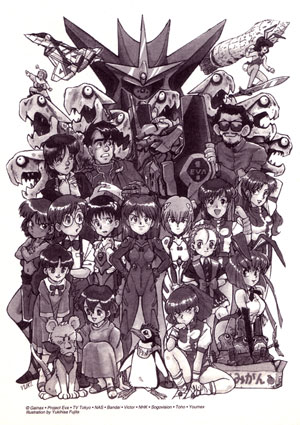
- Shounen Manga (I hosted a conversation with my friend Lillian Olsen, a veteran translator for Viz)
- Otaku Studies (I gave a talk, "The Importance of Being Otaku", followed by discussion)
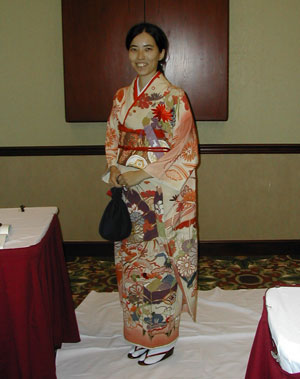 I was also supposed to be on the Anime Roundtable (discussing various issues relevant to anime fans), but that was cancelled (maybe next year). Also on Saturday, Lillian and I had a nice dinner with fellow guest Crispin Freeman (who went to the same high school as Lillian). On Friday, I helped Lillian during her kimono panel, but I was more of an audience member than a panelist. (see image on the right) Even though Saturday was hectic, I really enjoyed myself at the con. Anime Punch, put on by members of the OSU anime club, was open to the public for the first time last year. This year, to accomodate larger numbers, they decided to expand to a hotel. What the con staff lacked in experience, they made up for in enthusiasm. The attendees, knowing it was a new and small convention, were generally forgiving of minor hiccups and made the best of things. If the convention web forums are any indication, people had a lot of fun, and even the con staff seemed to be in better spirits as the weekend progressed and things fell more squarely into place. On Friday, I arrived before the con officially started, and my hotel room wasn't ready for me yet (nobody's fault; I just got there early), so I had nothing to do, and the con staff was scrambling to get things started on time. As such, I volunteered to help out. As a last minute volunteer (for about an hour), I helped move stuff around and put together registration packets. It was only a tiny fraction of work compared to the herculean effort shown by the real con staff (who were seriously sleep deprived), but it felt nice to help out, and it reminded me of the good old days of being part of an active anime club. Anime Punch was small, but it had a lot of good things going for it, things you don't always see at bigger and higher profile cons. The schedule was packed with things to do, even in the very early hours of the morning, so one had to prioritize carefully in order to make the most of their con experience. Different fans do different things at cons. For convention planners, the trick is to offer a wide variety of programming so fans of all stripes will always have something to do. Here are some of the many things I liked about the con:
I was also supposed to be on the Anime Roundtable (discussing various issues relevant to anime fans), but that was cancelled (maybe next year). Also on Saturday, Lillian and I had a nice dinner with fellow guest Crispin Freeman (who went to the same high school as Lillian). On Friday, I helped Lillian during her kimono panel, but I was more of an audience member than a panelist. (see image on the right) Even though Saturday was hectic, I really enjoyed myself at the con. Anime Punch, put on by members of the OSU anime club, was open to the public for the first time last year. This year, to accomodate larger numbers, they decided to expand to a hotel. What the con staff lacked in experience, they made up for in enthusiasm. The attendees, knowing it was a new and small convention, were generally forgiving of minor hiccups and made the best of things. If the convention web forums are any indication, people had a lot of fun, and even the con staff seemed to be in better spirits as the weekend progressed and things fell more squarely into place. On Friday, I arrived before the con officially started, and my hotel room wasn't ready for me yet (nobody's fault; I just got there early), so I had nothing to do, and the con staff was scrambling to get things started on time. As such, I volunteered to help out. As a last minute volunteer (for about an hour), I helped move stuff around and put together registration packets. It was only a tiny fraction of work compared to the herculean effort shown by the real con staff (who were seriously sleep deprived), but it felt nice to help out, and it reminded me of the good old days of being part of an active anime club. Anime Punch was small, but it had a lot of good things going for it, things you don't always see at bigger and higher profile cons. The schedule was packed with things to do, even in the very early hours of the morning, so one had to prioritize carefully in order to make the most of their con experience. Different fans do different things at cons. For convention planners, the trick is to offer a wide variety of programming so fans of all stripes will always have something to do. Here are some of the many things I liked about the con: - Unique video programming that featured cult classics, rare titles, staff picks, and documentaries. At most anime cons I attend, the video rooms are totally uninteresting, but Anime Punch had me repeatedly looking at the video schedule to make sure I wasn't missing anything special.
- The con was very open to panel suggestions, and as such, there were a ton of panels covering a wide range of subjects.
- Con Suite! The last time I was at an anime con that had a con suite was Otakon '97! Free soda and snacks are always a plus.
- In addition, there were great local food options. Usually, I spend more money in the dealers' room than I do on food, but this con had plenty of good restaurants nearby, whether you wanted fast food, casual dining, or really expensive steaks. Next year, even if the hotel changes, I hope the con stays in the same general area.
- Really nice con staff. As a guest, I was treated very well, and from the looks of it, the staff was just nice in general. I've been to too many cons where the con staff (volunteer or otherwise) were rude to attendees. Even when they were spread thin and lacking sleep, the Anime Punch staffers managed to stay friendly all throughout the weekend.
Thursday, March 30, 2006
My Thoughts on Anime : An Interview
In 2004, I was contacted by a high school student who was doing a research project on anime. As part of that project, she had to interview someone who was formally studying anime (and/or related topics). She found me through the Anime and Manga Research Circle and interviewed me over email. The questions were fairly general but fun to answer, and the interview allowed me to express thoughts concretely that were previously just floating around in my head.
Here is the interview (republished with permission):
1) What do you like about anime and manga?
I like many different things. First off, I like the stories and the art. I think animation allows one to do things in terms of exposition and special effects that you can't easily do in live action films. In my opinion, Japanese animation is currently doing a better job (than American animation) at expressing the full potential of animated stories.
There are so many anime production companies in Japan, and manga is well-respected as reading material (whereas Americans tend to view comics as being kids stuff). Because of these factors, perhaps, there is a wide variety of anime and manga available, targeted towards specific age groups, genders, etc. There's something for everyone, in other words.
I also like the fact that I can enjoy something produced by people from another culture. By watching anime and reading manga, I can learn about that other culture, or at least get a sense of their perspective on the world.
As an American fan, it's especially interesting that I'm not part of the target audience. These Japanese shows were not meant for me. Nonetheless, I can engage them on my own terms, and I can freely watch whatever genre I want. In Japan, if I was 27 years old, watching a show intended for 13 year old girls, people I know might look at me funny. But since I'm in America, watching something not meant for me in the first place, watching that show isn't as weird for some reason. I'm being entertained, but I'm also learning about a foreign culture, and if I don't care that I'm not part of one target audience, why should I care that I'm not part of another? There's a certain sense of freedom and self-determination I get when watching something that was not specifically marketed to me (and members of my demographic).
2) What got you interested in researching about it?
I've always been interested in extreme fandom, the way that people get involved with media products in ways that some people call "obsessive" and "unhealthy", in ways that the producers of those products never intended or would never hope for. I want to know what it is these extreme fans are doing, and why they do it. Where do they come from, and what do they get out of it? How do they deal with negative stereotypes that are used to characterize them? Japan has the perfect word for these kinds of fans: otaku. The focus of my research is on otaku. One can be an otaku of just about anything, not just anime or manga, but for some reason, anime and manga tends to attract otaku, maybe because the anime creators themselves are otaku and know what it is that otaku enjoy in their anime.
Since anime is my own domain of expertise, and I have participated heavily in American anime fandom, I am researching anime otaku in particular. I am specifically interested in how otaku use scientific methods and technology in interesting and unexpected ways.
This all fits into my broader interest regarding youth subcultures in general. Here are some questions I am trying to address: How are youth subcultures important, and maybe even useful, in mediating adolescent identity? Is it possible to have a "middle-class subculture", and if so, what does that imply? What conditions make "middle-class subcultures" necessary? How can subcultures provide an alternative to self-destructive youth violence?
3) How do you think the Japanese culture influence the America society?
Various aspects of Japanese popular culture are really making strong inroads into American popular culture. Some things, like Pokemon, have actually become mainstream, but I would say that most anime-related things have not yet achieved that status (and most probably never will). Anime is getting more and more popular, to be sure. How popular will anime get amongst the mainstream American population? Only time will tell.
In terms of anime relaying Japanese cultural norms that might be affecting American cultural norms, that is a much harder question. First, it's important to understand that American culture influences Japanese culture as well; for example, many anime creators have expressed their love of American movies. In this age of globalization, it's hard to say what is specifically Japanese culture versus American culture. I think I will leave this question for others to answer. [One aspect of this issue that strikes me as interesting, however, is the question of Japanese sexual norms (as portrayed in certain anime) potentially coming in conflict with American sexual norms.]
4) What are your ideas about cosplay?
I think cosplay is very interesting. I have friends who have done cosplay at major conventions, but I've never done it myself. I'd like to find out what motivates cosplayers.
5) Have you ever attended any anime festivals? If so, what was it like?
Yes, I've been to many anime conventions. I enjoy them very much. It's where otaku (and more casual fans) have a chance to truly be themselves and have fun amongst others who understand them. Cons are a great social experience, and I always look forward to them. Anime _can_ be enjoyed as a solitary pursuit, but sharing it with others has always been strongly appealing to me.
Monday, March 27, 2006
Counteracting Sameness on the Internet
The internet is considered a place where everyday people can creatively express themselves. That is certainly true, but you also see a lot of outright copying (and illicit republishing) of online material. Of course, the popular stuff gets copied the most, and is also the original source material for most of the derivative works, criticism, and analysis as well. In Science Studies, it's what we call the Matthew Effect (described by Robert Merton in 1968), which is essentially a restatement of the fact that the rich get richer and the poor get poorer. It's why, for example, certain blogs have thousands of inbound links, while the majority of blogs have none or just a handful. (Economists use the term "power law distribution" to describe this type of phenomenon. In describing the Matthew Effect, Merton gets into the psychosocial causes of this particular behavior and its implications.)
Because of the way Google works (ranking pages according to popularity), popular content on the Web is what gets noticed and becomes more popular over time while less popular content gets buried deeper and deeper over time, making it especially hard for new content and websites to get on an equal footing with old websites with pre-established audiences (and therefore good PageRank).
The content of popular sites is what tends to get replicated on other sites as well. With open sources of information like Wikipedia (published under the GNU Free Documentation License) becoming more and more popular with internet users, that content is also being heavily replicated (word-for-word in many cases) on other websites (including other popular online encyclopedias). As a result, alternative and less popular sources of knowledge become harder to find amidst the sea of copied information.
The ability to copy information without directly altering the original might avoid the 'tragedy of the commons', but it can result in a tragedy of another sort, a Tragedy of Sameness, a type of information entropy where all knowledge moves towards an equilibrium where everyone knows the same things about the same topics, and nothing really new is said or created.
Web content that can be copied and republished freely often becomes more popular than similar content that is more strictly controlled by their original authors, especially when the free content has been around longer. The tragedy occurs when this free (as in beer and as in speech) content is of lower quality than the non-free content, and the non-free high quality content can't compete in the long run and therefore disappears forever (to the detriment of everyone).
The precariousness of being in The Long Tail
It is said that The Long Tail is good for content that is not in high demand, that sites such as ebay, Amazon, and Netflix make it possible for niche content to survive and get exposure they wouldn't get otherwise (while making those companies a lot of money). Such sites and Long Tail content are mutually beneficial to each other.
Wikipedia also benefits from having a lot of niche content that could be considered in the Long Tail. There are many specialized articles that don't get read a lot, but the fact that they exist adds tremendous value to Wikipedia. (Print encyclopedias, on the other hand, are much more constrainted regarding the types of articles that get printed.) I'm not convinced, however, that Wikipedia is reciprocally beneficial to independent website creators, many of whom initially research and publish the valuable information that Wikipedia later incorporates. As Wikipedia and other megasites get popular, the independent websites are increasingly being pushed into the Long Tail of the Web and face the very real threats of obscurity and/or extinction.
The growing usage of megasites to get information on niche subjects can, in many cases, reduce the demand for independently created sites that cover the same content. With reduced demand, there becomes less incentive (monetary or otherwise) to produce such content independently, and the Web becomes populated by clones of Wikipedia articles and the other most popular sites on Google for any given subject. What used to be a collection of incredibly diverse (and sometimes quite expert) opinions and analysis on a multitude of subjects is increasingly becoming a boring monolith of sameness.
Even the new material posted on the internet these days that is considered "fresh and exciting content" is mostly superficial and ephemeral in its appeal, intended for audiences with brief attention spans. Scouring the Web for fascinating, well-researched, and wonderfully trivial details about arcane subjects has been replaced by surfing the Web for funny little photos and video clips, people's daily diaries, fanlistings, virtual slambooks, quickly accessible facts from reference pages, and easily digestible news articles (about current events, celebrity gossip, the latest tech gadgets, etc.) I browse and am entertained by those things too, I admit, but I'm also worried that "heavy" content on the Web is getting more and more scarce.
My Modest Attempts at Cultural Environmentalism
I try, even though it's hard, to avoid replicating the content (e.g. stuff on Slashdot or Digg) I read every day on the internet, a lot of which is actually fun stuff that lainspotting readers might be interested in. When I get the urge, however, I just remind myself that a ton of people are already linking to those things, and I don't need to add noise to the system.
I also try (with varying amount of success) to avoid linking to Wikipedia articles. Wikipedia is a great resource to quickly learn about new stuff, but I much prefer to support those independent website operators whose hard work results in truly original and in-depth content (that benefits from the accountability of having the author's name attached to it). Much of that content ends up being the (often uncredited) source material for Wikipedia and other megasites anyway, but in the process of being transferred, details get lost or are presented out of context.
Furthermore, Wikipedia contributors and editors tend to err on the side of caution (or stinginess, depending on your point of view) regarding external links (whether it was the source of the info, or alternative information) for fear of link-spamming. Yet, robust linking is what made the web great to begin with. It's becoming a lost tradition. Few people, even small website owners, want to link to potential competitors for fear of losing ad revenue in the long run. That search engine optimizers have to debate whether or not outbound links will negatively affect their PageRank is another tragedy, and the quality of the Web is suffering because of it.
Google and Originality
Ironically, I started this post with the intention of writing just one or two lines on how Google can be used to aid creativity. I just wanted to note that Google is a great tool for checking to see if a phrase you came up with has been coined or used before by anyone else. In something I wrote a few weeks back, I used the phrase "toothless ambition" and wondered if anyone had used it before me. Google says no, so I'll claim it as my own. =)
Related links
Browsers and the quality of web content [edit: added 3/28/06]
What happened to anime "shrines" on the web?
Friday, March 24, 2006
Murakami does the NYU Course Catalog
Do course catalogs get any cooler? Pop/otaku artist Takashi Murakami designed the cover of this recent NYU catalog:
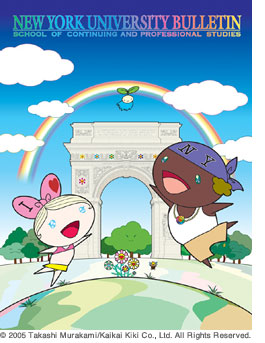
More info: NYU -SCPS's ANIMEted Summer
Pre-web anime fandom (Out of the Archives 4)
In the late 80's and early 90's, the internet was not yet widely available to the American public. Anime fans were already online, however, communicating with each other and sharing resources on services such as Prodigy, CompuServe, AOL, and GEnie. On a more local level, anime content could also be found on some BBSes, and there were even some anime-specific BBSes. Those who had access to the internet also shared material via Usenet, FTP, and Gopher. A lot of these became much less important after the World Wide Web took off in the mid-90's, but looking back, we can appreciate how they paved the way for today's vast information culture surrounding anime.
Here is a print ad from 1991 for the anime discussion boards found on GEnie.

Students of CJAS history should take note that one of the two sysops for the anime board was Richard Copeland, who (according to the ad) regularly attended CJAS (then known as CJS, the Cornell Japanimation Society). Lea Hernandez, the other sysop, was the vice president of General Products USA (the American merchandising division of Gainax) from 1989-1990.
One way that old school anime fans shared information with each other was through text files that were distributed across various bulletin boards. Anime Stuff, first published by Tom Mitchell in January of 1987, was one of the most well-known newsletters. Tom was a sysop of "The CompuServe Anime & Manga Forum". Starting with issue #5 (11/12/1987), none other than CJAS co-founder and first president Masaki Takai joined Tom in producing the newsletter. Masaki, then a freshman at Cornell, hadn't even started CJAS yet (the club was "born" on September 9th, 1988).
Issues (with associated images) of Anime Stuff are still available for download at the SUNET FTP archive's mirror of the much-loved but now-defunct Venice anime and manga FTP archive: Index of /pub/comics/anime-manga/anime.stuff
An even more accessible collection of Anime Stuff can be found here: Index of /OSA/PUBLICATIONS/anime-stuff courtesy of J!-ENT's Old School Anime website, which is a pretty fun read if you were a fan from that time, or if you're interested in that particular era of fandom.
Years before the CJAS newsletter was started in 1992, Masaki was already contributing heavily to Anime Stuff. Search the following index to find the articles he submitted: asindex6.pdf
Some readers might be interested in the interviews with Roe Adams and Masaki, in issues 17 and 20 respectively, where they talk about the early days of CJAS and the founding of Animeigo.
Related articles
Otaku no CJAS: Graffiti of the Otaku Generation 1988
10 Years of Decadence, CJAS-Style (another CJAS history article)

One way that old school anime fans shared information with each other was through text files that were distributed across various bulletin boards. Anime Stuff, first published by Tom Mitchell in January of 1987, was one of the most well-known newsletters. Tom was a sysop of "The CompuServe Anime & Manga Forum". Starting with issue #5 (11/12/1987), none other than CJAS co-founder and first president Masaki Takai joined Tom in producing the newsletter. Masaki, then a freshman at Cornell, hadn't even started CJAS yet (the club was "born" on September 9th, 1988).
Issues (with associated images) of Anime Stuff are still available for download at the SUNET FTP archive's mirror of the much-loved but now-defunct Venice anime and manga FTP archive: Index of /pub/comics/anime-manga/anime.stuff
An even more accessible collection of Anime Stuff can be found here: Index of /OSA/PUBLICATIONS/anime-stuff courtesy of J!-ENT's Old School Anime website, which is a pretty fun read if you were a fan from that time, or if you're interested in that particular era of fandom.
Years before the CJAS newsletter was started in 1992, Masaki was already contributing heavily to Anime Stuff. Search the following index to find the articles he submitted: asindex6.pdf
Some readers might be interested in the interviews with Roe Adams and Masaki, in issues 17 and 20 respectively, where they talk about the early days of CJAS and the founding of Animeigo.
Related articles
Otaku no CJAS: Graffiti of the Otaku Generation 1988
10 Years of Decadence, CJAS-Style (another CJAS history article)
Saturday, March 18, 2006
Maid in Akihabara : Episode 1 Review and Analysis
"What kind of place is this?" - Saki, upon entering the weird world of otaku
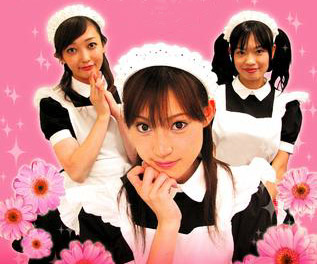 Last night, my wife and I watched and enjoyed the first 15-minute episode (out of six) of Maid in Akihabara (2005), a live-action Japanese comedy about a young woman, Saki, who becomes a server at a maid cafe in Akihabara, the world's most famous "geek ghetto", as the Washington Post puts it. Obviously, as a server in a maid cafe, she has to dress up as a maid, serving otaku customers looking for company and relaxation after, say, a long day of anime shopping or a night of waiting in line to score the perfect autograph to go on the perfect piece of anime/manga/game related merchandise. Needless to say, this world is completely foreign to Saki, but despite some initial discomfort, she tries to make the best of her situation.
Last night, my wife and I watched and enjoyed the first 15-minute episode (out of six) of Maid in Akihabara (2005), a live-action Japanese comedy about a young woman, Saki, who becomes a server at a maid cafe in Akihabara, the world's most famous "geek ghetto", as the Washington Post puts it. Obviously, as a server in a maid cafe, she has to dress up as a maid, serving otaku customers looking for company and relaxation after, say, a long day of anime shopping or a night of waiting in line to score the perfect autograph to go on the perfect piece of anime/manga/game related merchandise. Needless to say, this world is completely foreign to Saki, but despite some initial discomfort, she tries to make the best of her situation.If you're at all interested in Akihabara, otaku, and the curious phenomenon of maid/cosplay cafes, this comedy is for you. The idea of maid cafes might sound a bit distasteful to some, but if you've never been to one, what goes on inside might surprise you, which makes Maid in Akihabara worth watching. Just keep in mind that the show exaggerates many things in order to entertain the audience, but like all good comedies, those exaggerations are based on elements of truth. Another thing to keep in mind is that not all (or even most) otaku visit maid cafes. Works of fiction and news agencies alike, trying to present simple and coherent stories, often neglect to mention the diversity of otaku culture, which is actually quite complex. Also, for the sake of this review, when I refer to otaku, I'm talking primarily about male (and heterosexual) otaku, even though female otaku certainly exist.
I've never been to a maid cafe myself, but the descriptions I've heard and read of them seem to match (at least vaguely) what I saw in the comedy. Besides the typically fun portrayals of otaku interacting with each other in their natural habitat (something that I personally relate to), the show also gets into the fascinating interactions between the otaku and the maids who are serving them.
Some might find those interactions creepy, but I found them to be surprisingly sensitive. Even though the maids acted out submissive roles, they maintained strong boundaries over what was acceptable and always sought to maintain control of the situation. Except for some nervous ogling, and the very basic fact that the maids were dressed for their benefit, the otaku treated the maids with an enormous amount of respect and courteousness, as if they were celebrities. The otaku didn't boss them around, make inappropriate advances toward them, or otherwise act misogynistically. Their general vibe was one of immense gratefulness. Instead of pretending to be Casanovas--bragging about sexual conquests and the ability to seduce women--the otaku were honest about their inexperience with the opposite sex.
Maid Cafes and Otaku Sexuality
If we consider maid cafes to be sexist, it's because of the role otaku prefer for the women--clearly subservient, completely unthreatening, unswervingly adoring, unconditionally faithful, and pure of both mind and body. Undoubtedly, the maids at these cafes represent an antiquated ideal of womanhood. This phenomenon is not new. Strip clubs and bars where the waitresses have to dress up in bunny outfits both feature women who serve at the pleasure of male clientele. Some people who complain about such places will say that those establishments are reflections/manifestations of male-dominated society. Yet, while Japan certainly has its share of gender inequality, I would be very shocked to hear that otaku who frequent maid cafes are at all dominant over women in real life (except for the extreme minority who become involved in sex crimes). For most otaku, the interactions they have with women at maid cafes are a complete fantasy.
The real question, left unanswered by the show, is how the otaku patrons of maid cafes feel about real women, what their expectations are of the opposite sex outside of the maid fantasy world. Are these cafe visits brief moments of escapist fantasy, or do they represent (or at least influence) Japanese otaku's broader worldviews about women in general? The common perception is that male otaku in Japan don't (and often don't want to) interact intimately with women very much, especially if the women are not otaku themselves. (See the troubled hero of Densha Otoko for an example of an otaku who struggles to do just that.)
Is such lack and difficulty of interaction exacerbated by these maid fantasies? Does being a fan of moe hurt one's prospects of having healthy relationships with real women? I don't actively study otaku in Japan, so I won't draw any conclusions about that, but I'm going to safely guess that the answer is not black and white. Being into moe, or pornography for that matter (itself mostly fantasy), can be unhealthy if taken to certain extremes, but I don't think it has to be, and it probably isn't unhealthy most of the time for most people.
Most of the American otaku I've met (males and females, fans of moe included) are pretty well-balanced individuals who are able to interact well with each other and non-otaku. The influx of female and younger fans has resulted in a different kind of socialization, compared (for example) to American anime fandom 10 years ago, and I think the effect has been positive overall. Today, a diverse mix of people in America are proud to call themselves otaku.
Related links
'Maid in Japan' cafes treat geeks like lords One of many articles describing the maid cafe phenomenon
New Butler Cafe to Cater to Otaku Girls Female otaku looking for some pampering are not left out
Original Video / Maid in Akihabara DVD (released on 2/24/06) available at cdjapan; site includes cast information
A note on the references in the show
When the otaku are talking in the cafe, they routinely refer to real life shows. I'm not an expert on all the references, but I do recognize some of the more obvious ones, like Mobile Suit Gundam quotes. One reference I wanted to bring up, however, is the discussion the two otaku had about Ultra Seven (1967-1968) episode 12.
 I definitely am not an expert on tokusatsu, but I have read about the "banned" 12th episode of Ultra Seven. To make a long story short, other than the original broadcast, the episode was never again broadcast or released in Japan, and no mention of the episode is ever made in any of the official reference books for the show. Due to a controversy over the naming of one of the monsters (it sounded too much like the name given to survivors of the Hiroshima and Nagasaki bombings), the studio promised to seal the episode away forever (though the English dub of the episode has been broadcast a few times outside of Japan).
I definitely am not an expert on tokusatsu, but I have read about the "banned" 12th episode of Ultra Seven. To make a long story short, other than the original broadcast, the episode was never again broadcast or released in Japan, and no mention of the episode is ever made in any of the official reference books for the show. Due to a controversy over the naming of one of the monsters (it sounded too much like the name given to survivors of the Hiroshima and Nagasaki bombings), the studio promised to seal the episode away forever (though the English dub of the episode has been broadcast a few times outside of Japan).Even more interesting is the fact that Tsutomu Miyazaki, the man whose heinous crimes caused Japan's mainstream media to incite widespread fear and hatred of otaku, had a copy of this banned episode (see the second link below). I've also read that he used his bootleg copy as a valuable bargaining chip to obtain other (oftentimes illicit) material. [Unfortunately, I've lost my source for that second bit of information, so if you know anything about it, please let me know.] By referencing this rare Ultra Seven episode, the writers of Maid in Akihabara are showing us that otaku know about things that normal 'civilians' do not, and maybe the writers are also indirectly evoking the memory of Miyazaki's crimes.
Related links
The Banned Ultraseven Episode Informative Usenet posting
ULTRA SEVEN: BANNED! Scroll down on that page to see the article
Thursday, March 16, 2006
SNK brochures 1996 (Out of the Archives 3)
In the summer of 1996, I sent a letter to the American branch of SNK asking for information and promotional material for an article I was planning to write for the CJAS Newsletter. The company kindly sent me back a large folder/brochure that included game flyers and catalogs.
I've seen some of the same flyers and catalogs online at The Arcade Flyer Archive, a truly magnificent resource for those who fondly look back at the glory days of video arcades in America, Asia, and elsewhere.
I have scanned the flyers and catalog that I didn't see on that archive, as well as the folder/brochure they came in [the scanner bed was smaller than the folder, so some of the images are slightly cut off]. I hope to submit these images to that site.

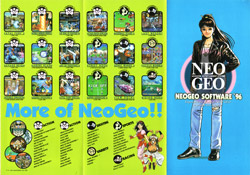

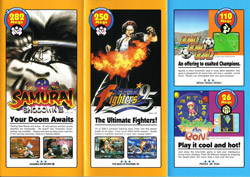
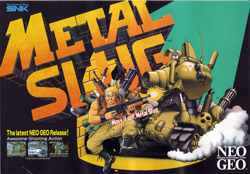

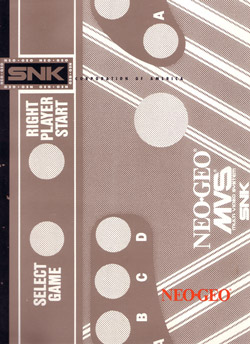


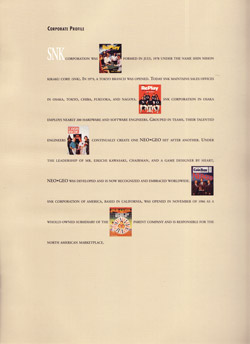


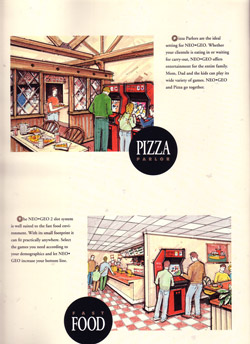

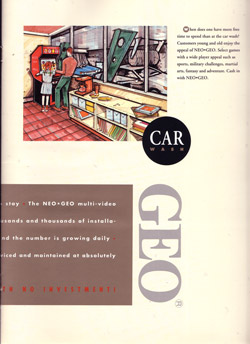

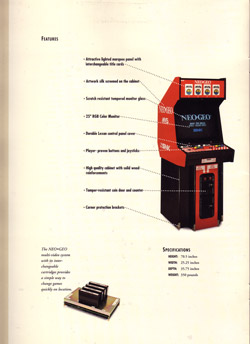

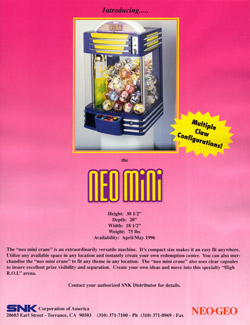
Speaking of old software publications, I recently read about Jason Scott's project of scanning in old computer ads, brochures, flyers, etc. Scott also produced a highly acclaimed documentary about the BBS scene. I got into BBSes pretty late, but in Korea in 1993, English-language BBSes were the closest thing a kid like me had to the internet (by 1994, I was using the internet at Cornell).
All of this scanning, archiving, and documentation of geek history reminds me of what William Gibson said:
We are all curators, in the post-modern world, whether we want to be or not.
I've seen some of the same flyers and catalogs online at The Arcade Flyer Archive, a truly magnificent resource for those who fondly look back at the glory days of video arcades in America, Asia, and elsewhere.
I have scanned the flyers and catalog that I didn't see on that archive, as well as the folder/brochure they came in [the scanner bed was smaller than the folder, so some of the images are slightly cut off]. I hope to submit these images to that site.



















Speaking of old software publications, I recently read about Jason Scott's project of scanning in old computer ads, brochures, flyers, etc. Scott also produced a highly acclaimed documentary about the BBS scene. I got into BBSes pretty late, but in Korea in 1993, English-language BBSes were the closest thing a kid like me had to the internet (by 1994, I was using the internet at Cornell).
All of this scanning, archiving, and documentation of geek history reminds me of what William Gibson said:
Subscribe to:
Posts (Atom)